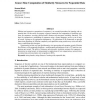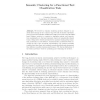100 search results - page 8 / 20 » Learning distance function by coding similarity |
BMCBI
2004
13 years 7 months ago
2004
Background: In addition to known protein-coding genes, large amounts of apparently non-coding sequence are conserved between the human and mouse genomes. It seems reasonable to as...
KDD
2012
ACM
11 years 10 months ago
2012
ACM
In recent years, both hashing-based similarity search and multimodal similarity search have aroused much research interest in the data mining and other communities. While hashing-...
JMLR
2008
13 years 7 months ago
2008
Efficient and expressive comparison of sequences is an essential procedure for learning with sequential data. In this article we propose a generic framework for computation of sim...
NIPS
2004
13 years 9 months ago
2004
The representation of acoustic signals at the cochlear nerve must serve a wide range of auditory tasks that require exquisite sensitivity in both time and frequency. Lewicki (2002...
CICLING
2009
Springer
14 years 8 months ago
2009
Springer
Abstract. We describe a semantic clustering method designed to address shortcomings in the common bag-of-words document representation for functional semantic classification tasks....


